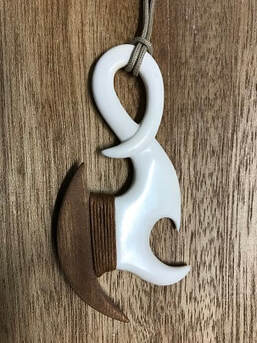|
After a few quiet weeks caused by my point carver motor being re-wound, these last few have been busy in the workshop. The motor is going really well again! This just goes to support my oft-mentioned exhortation to keep your equipment in tip-top condition, because a breakdown can stop you in your tracks for weeks, especially in lockdown, as we are in Sydney at the moment (and we are not alone in Australia or the world). I reassembled my point carver, oiling and tightening a few parts as I went, and got to work happily. I started by trying to catch up with a few commissions – a very good place to start I thought! I had some bone-work to do, and after trying Kudu horn-inner for one piece, and finding it too soft and brittle for the design (it broke), needed to obtain some fresh beef bone for the work because I could not find the old beef thigh bone I carried around for years. It just goes to show – you should only throw-away things you will never, ever, need again! I can thoroughly recommend Steve Myhre’s book on bone carving (it’s listed in the references at the bottom of the About Jade page in this site) to give you all the information you need to know about cleaning and preparing bone for bone carving. It’s not a quick process though – I took me about a week to clean and de-grease mine. An important point: once you have your bone cleaned and ready, you need to cut it the correct way to give you the thickest bone just where you need it for the design. Uncooked beef bone (the central section of either the fibula (lower leg) or tibia (thigh/upper leg bone)) are what you need for carving. I cut the first one the wrong way and dissected the thickest portion of the bone, which I needed for the design, so had to buy another and cut it correctly! Whilst that bone was soaking, I made a couple of trial pieces to test the design and techniques I wanted to use and was happy with the results. However, whilst bone is softer than my more usual nephrite carving medium, great care needs to be taken in the grinding and polishing process. Every scratch needs to be ground out or the finish is spoilt. Similarly, any imperfections in the bone show up in a very negative way. You can’t do anything about the thickness of the bone – there is only the good, solid part to use. This then necessitated careful study of my piece of bone, much as I do with my stone, to find the best orientation for the design. I’m taking a short break from bone carving and am happy to get back to carving nephrite to complete a small batch of koalas, one of which is increasingly becoming a bit of a rush job. I’m trying a new pose for the creature, and wasn’t sure how the head would relate to the shoulders, having only one picture of the koala in that position. So, as I often suggest, I made a model out of Plasteline/plasticine modelling clay. This will, I hope, prevent me from adding to the selection of “failures” at the back of the bench awaiting a new design to help them rise, Phoenix-like from the proverbial ashes!
Happy carving!
0 Comments
|
AuthorOn this page I intend to add monthly updates on aspects of jade carving. I also plan to invite more experienced carvers to offer a "master-class" on a particular subject of their choice. With this I hope to enthuse both the novice and the expert in this ancient and beautiful art-form/craft. And comments are welcome! Archives
March 2024
Categories |




 RSS Feed
RSS Feed